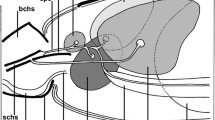Abstract
The ultrastructure of the flank gland tissue of both sexes of the Indian musk shrew,Suncus murinus viridescens was investigated. The undifferentiated and differentiated sebaceous secretory cells in the glands of both sexes possess 1–8 mitochondrial dense osmophilic inclusions. A few inclusions of medium electron density, and clear vacuoles were also seen in the mitochondria. The muscle fibres in the glandular complex were devoid of these characteristic mitochondrial inclusions. Secretory activity of the well differentiated sebaceous cells was characterised by the presence of a number of large secretory granules. Mitochondria and polyribosomes were found in close association with the secretory granules. The flank gland tubules of the shrew were highly vascularised.
Similar content being viewed by others
References
Balakrishnan M 1975Studies on mammalian behaviour: Aspects of ethology of the Indian musk shrew, Suncus murinus viridescens (Blyth); Ph.D. thesis, University of Kerala, Trivandrum
Balakrishnan M and Alexander K M 1977a Histology and histochemistry of the flank gland of the Indian musk shrew;Acta theriol 22 241–249
Balakrishnan M and Alexander K M 1977b A study of physiology and biochemistry of the flank gland of the musk shrew,Suncus murinus viridescens (Blyth);T.I.T.J. Life Sci. 7 13–21
Balakrishnan M and Alexander K M 1980 A study on scent marking and its olfactory inhibition in the Indian musk shrew,Suncus murinus viridescens (Blyth);Bonn. zool. Beitr. 31 2–13
Balakrishnan M and Alexander K M 1985 Sources of body odour and olfactory communication in some Indian mammals;Indian Rev. Life Sci. 5 277–313
Balakrishnan M, Alexander K M and George J C 1984 Observations on the fine structure of the sebaceous flank gland of the Indian musk shrew,Suncus murinus viridescens (Blyth);Proc. Indian Acad. Sci. (Anim. Sci.) 93 655–662
Bell M 1974 Effect of androgen on the ultrastructure of the sebaceous gland in two species;J. Invest. Dermatol. 62 202–210
Bjersing L 1967 On the ultrastructure of granulosa lutein cells in porcine corpus luteum with special reference to endoplasmic reticulum and steroid hormone synthesis;Z. Zellforsch. 82 187–211
Ellis R A and Henrikson R C 1963 The ultrastructure of the sebaceous glands of man; inAdvances in Biology of Skin, The Sebaceous Glands (eds) W Montagna, R A Ellis and A Silver (Oxford: Pergamon Press)4 94–109
Fawcett D W 1981The Cell, 2nd edition (Philadelphia: Saunders Company)
Gorgas K and Völkl A 1984 Peroxisomes in sebaceous glands. IV. Aggregates of tubular peroxisomes in the mouse Meibomian gland;Histochem. J. 16 1079–1098
Jenkinson M D, Elder H Y, Mongomery J and Moss V A 1985 Comparative studies on the ultrastructure of sebaceous gland;Tissue Cell 17 683–698
Kurosumi K 1961 Electron microscopic analysis of the secretion mechanisms;Int. Rev. Cytol. 11 1–124
Müller-Schwarze D 1983 Scent glands in mammals and their functions; inAdvances in the study of Mammalian Behavior (eds) J F Eisenberg and D G Kleiman;Spec. Publ. Am. Soc. Mamm. 7 150–197
Mykytowycz R 1970 The role of skin glands in mammalian communication; inAdvances in Chemoreception, Communication by Chemical Signals (eds) J W Johnston, D G Moulton and A Turk (New York: Appleton-Century-Crofts)1 327–360
Quay W B 1972 Integument and the environment: Glandular composition, function and evolution;Am. Zool. 12 95–108
Reynolds E S 1963 The use of lead citrate at high pH as an Electron-opaque stain in electron microscopy;J. Cell Biol. 17 208–212
Sansone G, Swartzendruber D C and Snyder F 1970 Inclusions in mitochondria of preputial glands from mice: A combined biochemical and morphological study;Biochem. Biophys. Acta 201 401–409
Sokolov V E, Basurmanova O A and Chernova O F 1986 Ultrastructure of the specific skin paranasal glands of common noctule (Mammalia: Chiroptera, vespertilionidae) sebaceous glands;Rep. Acad. Sci. USSR 288 236–238
Strauss J S, Pochi P E and Downing D T 1976 The sebaceous glands; Twenty five years of progress;J. Invest. Dermatol. 67 90–97
Author information
Authors and Affiliations
Rights and permissions
About this article
Cite this article
Balakrishnan, M., Sokolov, V.E. & Basurmanova, O.A. Further observations on the ultrastructure of the flank gland of the musk shrew,Suncus murinus viridescens (Blyth). Proc. Indian Acad. Sci. (Anim. Sci.) 95, 667–675 (1986). https://doi.org/10.1007/BF03179480
Received:
Revised:
Issue Date:
DOI: https://doi.org/10.1007/BF03179480




